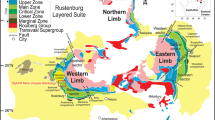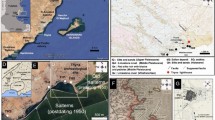Abstract
Rocks described as “chert” from the North Atlantic, recovered during the Deep Sea Drilling Project, consist of quartz or disordered cristobalite. They occur in a wide variety of sediment types; only a few are associated with radiolarian oozes. Some of the cristobalitic cherts contain abundant clinoptilolite or palygorskite and sepiolite.
The cherts have a variety of origins. They are most probably replacement cherts at sites 5, 6, and 7; direct alteration products of radiolarian ooze at site 8; and either alteration products of volanic glass or direct precipitates from hydrothermal solutions at sites 9 and 12. Evidence for these diverse origins is preserved as unusual mineral assemblages in these geologically young rocks.
Similar content being viewed by others
References
Beall, A.O., Fischer, A.G.: Sedimentology. In: Ewing, M., et al., Initial reports of the deep sea drilling project, vol. I, p. 521–593. Washington: U.S. Government Printing Office 1969.
Bonatti, E., Joensuu, O.: Palygorskite from Atlantic deep sea sediments. Am. Mineralogist 53, 975–983 (1968).
Bowles, F.A., Angino, E.E., Hosterman, J.W., Galle, O.K.: Precipitation of deep-sea palygorskite and sepiolite. Earth and Planet. Sci. Letters 11, 324–332 (1971).
Bramlette, M.N.: The Monterey Formation of California and the origin of its siliceous rocks. U.S. Geol. Surv. Profess. Papers 212, 57 pp. (1946).
—, Posnjak, E.: Zeolite alteration of pyroclasitics. Am. Mineralogist 18, 167–171 (1933).
Brown, G., Catt, J.A., Weir, A.H.: Zeolites of the clinoptilolite-heulandite type in sediments of southeast England. Mineral. Mag. 37, 480–488 (1969).
Calvert, S.E.: Accumulation of diatomaceous silica in the sediments of the Gulf of California. Geol. Soc. Am. Bull. 77, 569–596 (1966).
Carozzi, A.V.: Microscopic sedimentary petrography. 485 pp. New York: John Wiley & Sons, Inc. 1960.
Chester, R., Elderfield, H.: The infra-red determination of opal in siliceous deep-sea sediments. Geochim. Cosmochim. Acta 32, 1128–1140 (1968).
Deffeyes, K.S.: Zeolites in sedimentary rocks. J. Sediment. Petrol. 29, 602–609 (1959).
Ernst, W.G., Calvert, S.E.: An experimental study of the recrystallisation of porcelanite and its bearing on the origin of some bedded cherts. Am. J. Sci. A267, 114–133 (1969).
Ewing, J.I., Ewing, M.: Reflection profiling in and around the Puerto Rico Trench. J. Geophys. Res. 67, 4729–4739 (1962).
Ewing, J., Worzel, J.L., Ewing, M., Windisch, C.: Age of Horizon A and the oldest Atlantic sediments. Science 154, 1125–1132 (1966).
Ewing, M., Worzel, J. L., Beall, A. O., Berggren, W. A., Bukry, D., Burk, C. A., Fischer, A. G., Pessagno, E. A.: Initial reports of the deep sea drilling project, vol. I, 672 p. Washington: U.S. Government Printing Office 1969.
Flörke, O.W.: Zur Frage des „Hoch“: Cristobalite in Opalen, Bentoniten and Gläsern. Neues Jahrb. Mineral. Monatsh. 217–233 (1955).
Gartner, S.: Sea-floor spreading, carbonate dissolution level and the nature of Horizon A. Science 169, 1077–1079 (1970).
Gibson, T.G., Towe, K.M.: Eocene volcanism and the origin of Horizon A. Science 172, 152–154 (1971).
Grunau, H.R.: Radiolarian cherts and associated rocks in space and time. Ecologae Geol. Helv. 58, 157–208 (1965).
Habib, D.: Middle Cretaceous palynomorphs in a deep-sea core from the seismic reflector Horizon A outcrop area. Micropaleontology 15, 85–101 (1969).
—: Middle Cretaceous palynomorph assemblages from clays near the Horizon beta deep-sea outcrop. Micropaleontology 16, 345–379 (1970).
Hathaway, J.C., Sachs, P.L.: Sepiolite and clinoptilolite from the Mid-Atlantic Ridge. Am. Mineralogist 50, 852–867 (1965).
—, Schlee, J.S.: Stratigraphy and mineralogy of sediments cored off Northern Florida. Geol. Soc. Am. Spec. Papers 101, 437 (1968).
Hay, R.L.: Stratigraphy and zeolitic diagenesis of the John Day Formation of Oregon. Univ. Calif. Publ. Geol. Sci. 42, 199–262 (1963).
- Zeolites and zeolitic reactions in sedimentary rocks. Geol. Soc. Am. Special Papers 85, 130 pp. (1966).
Heezen, B.C., Nesteroff, W.D., Oberlin, A., Sabatier, M.G.: Deconverte d'attapulgite dans les sediments profonds du golfe d'Aden et de la mer Bouge. Compt. Rend. Soc. Geol. Paris 260, 5819 (1965).
JOIDES Deep sea drilling project. Bull. Am. Assoc. Petrol. Geologists 51, 1787–1802 (1967).
Jones, J.B., Sanders, J.V., Segnit, E.R.: Structure of opal. Nature 204, 990–991 (1964).
—: The nature of opal, I. Nomenclature and constituent phases. J. Geol. Soc. Australia 18, 57–68 (1971).
Klug, H.P., Alexander, L.E.: X-ray diffraction procedures. 716 pp. New York: John Wiley & Sons, Inc. 1954.
Lipincott, E.R., Valkenburg, A.V., Weir, C.E., Bunting, E.N.: Infra-red studies on polymorphs of silicon dioxide and germanium dioxide. J. Res. Natl. Bur. Std. 61, 61–70 (1958).
Melson, W.G., Thompson, G., Andel, Tj. H. van: Volcanism and metamorphism in the Mid-Atlantic Ridge, 22°N Latitude. J. Geophys. Res. 73, 5925–5941 (1968).
Mizutani, S.: Transformation of silica under hydrothermal conditions. Nagoya Univ. J. Earth Sci. 14, 56–88 (1966).
Peterson, M.N.A., Borch, C.C. von der: Chert: modern inorganic deposition in a carbonateprecipitating locality. Science 149, 1501–1503 (1965).
—, Borch, C.C. von der, Edgar, N.T., Cita, M., Gartner, S., Goll, R., Nigrini, C., von der Borch, C.: Initial reports of the deep sea drilling project, vol. II, 501 p. Washington: U.S. Government Printing Office 1970.
Rex, R.W.: X-ray mineralogy studies — Leg 1. In: Ewing, M., et al., Initial reports of the deep sea drilling project, vol. I, p. 354–367. Washington: U.S. Government Printing Office 1969.
—: X-ray mineralogy studies—Leg 2. In: Peterson, M.N.A., et al.: Initial reports of the deep sea drilling project, vol. II, p. 329–346. Washington: U.S. Government Printing Office 1970.
Rey, T.: Ultrarotabsorption von AlPO4 and SiO2 in Abhängigkeit von Fehlordnung und Temperatur. Z. Krist. 123, 266–314 (1966).
Reynolds, W.R.: Mineralogy and stratigraphy of Lower Tertiary clays and claystones of Alabama. J. Sediment. Petrol. 40, 829–838 (1970).
Rieck, Cl.D., Stevels, M.J.: The influence of some metal ions on the devitrification of glasses. J. Soc. Glass Tech. 35, 284–288 (1951).
Smith, W.E.: The siliceous constituents of chert. Geol. Mijnbouw 39, 1–8 (1960).
Sosman, R.B.: The phases of silica, 388 pp. New Brunswick: Rutgers Univ. Press 1965.
White, D.E., Brannock, W.W., Murata, K.J.: Silica in hot-spring waters. Geochim. Cosmochim. Acta 10, 27–59 (1956).
-Thompson, G.A., Sandberg, C.H.: Rocks, structure and geologic history of Steamboat Springs Thermal area, Washoe County, Nevada. U.S. Geol. Surv. Profess. Papers 458-B, 63 pp. (1964).
Wolf, K.H.: Textural and compositional transitional stages between various lithic grain types with a comment on interpreting detrital modes of graywacke and arkose. J. Sediment. Petrol. 41, 328–332 (1971).
Author information
Authors and Affiliations
Rights and permissions
About this article
Cite this article
Calvert, S.E. Composition and origin of North Atlantic deep sea cherts. Contr. Mineral. and Petrol. 33, 273–288 (1971). https://doi.org/10.1007/BF00382569
Received:
Issue Date:
DOI: https://doi.org/10.1007/BF00382569




